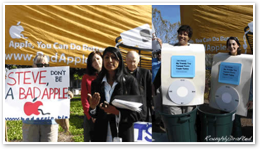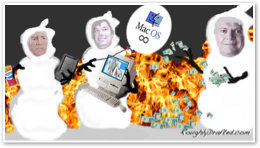
Marketing Macs in a PC World
An accidental discovery that turned out to be key to Apple's recovery was presented in Why Apple Bounced Back. While critically important, it wasn't the only way the new Apple revitalized its Mac platform. Another contributing factor to the company's rebound involved Apple’s learning how to effectively sell its products. Apple's unique Mac required a new sales strategy; the ones used by PC makers weren't going to work.
The Marketing of Macs in a PC World
Why Apple Failed described why a new strategy was necessary. It outlined the difference between PC market share, which analysts demanded Apple chase, and Mac market expansion, what the platform really needed.
Apple desperately needed to reach a wider audience, but its sales rank within the overall market for similarly sized computers wasn't really that critical. The reason: Macs weren't simply another flavor of standard PCs.
That principle cut both ways: being unique meant that Apple's Macs were not drop in replacements for PCs in many applications, but it also meant that Apple could more easily retain certain markets based on its stronger customer loyalty.  So while HP and Dell could offer PCs to serve categories that Apple couldn't, they also found it much more difficult to poach Mac sales than to steal PC sales from each other.
So while HP and Dell could offer PCs to serve categories that Apple couldn't, they also found it much more difficult to poach Mac sales than to steal PC sales from each other.
 So while HP and Dell could offer PCs to serve categories that Apple couldn't, they also found it much more difficult to poach Mac sales than to steal PC sales from each other.
So while HP and Dell could offer PCs to serve categories that Apple couldn't, they also found it much more difficult to poach Mac sales than to steal PC sales from each other.More recently, as Apple has increased that differentiation with unique software, the Mac has become not only a more compelling product for users, but has also earned increased loyalty. That makes it far more difficult for rivals to erase Apple’s gains.
Market share has always been an important metric for HP, Dell and other generic PC makers, because they all sell functionally identical, undifferentiated machines. The overall PC market has long been a contentious pool of commodity equipment that can be supplied by anyone with a screwdriver and an OEM license from Microsoft. For generic PC makers, market share is all that matters.
PCs Only
Apple has never directly competed in the market for Windows compatible PCs; in fact, Apple purposely avoided vast segments of the PC market. This includes the low profit, low performance economy box PCs that HP and Dell dump upon unwary consumers as instant eWaste, and the high volume PC boxes ordered in bulk by the Enterprise to serve as simple dumb terminal replacements. 

In both of these segments, Apple has little to offer competitively. Other companies can simply ship cheaper components more efficiently. Apple's core, differentiated strengths in offering tight software integration and a richly engineered overall experience matter little to customers who are only interested in a rock bottom price or minimal functionality in a utility PC.
The Mac Market
On the other hand, Macs have historically held a strong position in specific, specialized markets: education, creative print, web, and graphic design, as well as in new, emerging segments. Macs blazed the trail in multimedia applications and were over-represented on the Internet and later the web in its commercial infancy. Macs are prominently used in music and film and other areas where integration and polish matter.
Apple's dominance in creative applications isn't a coincidence. Macs simply served as higher quality tools for artists and technicians who understood the value of buying computers with tighter integration, and which "just work" without requiring a large team of IT people to provide remedial support.
Businesses Shoot Themselves in the Face
Somewhat ironically, it has been business users who have thrown their money into bad technology investments. Blinded by the Myth of Expensive Macintoshes, they failed to see that upfront hardware cost differences are simply trivial in comparison to ongoing support costs and software licensing fees.
Hiring one IT person, with a $40-60,000 salary, offsets many thousands of dollars of hardware costs. Further, the required software licenses, client access licenses, and excessive support costs required by Windows PCs far outweighs the expense of buying premium machines over loss leader junk computers.
Rather than hiring remedial IT people to support poor quality PCs and roll out expensive layers of Microsoft software licenses, businesses could be investing in hardware with a longer usable life span, a significantly greater resale value, far lower support costs, and then using the savings to train and equip their employees to be more productive.
The WalMartization of corporate IT has enslaved tech workers to a monoculture of low productivity business applications which have seen little technical progress in the last decade. The willingness to invest in poor quality desktop PCs running poorly engineered software has spawned further crisis as companies scramble to retrofit insecure, unproductive, and fragile systems plagued by malware, spyware, viruses, and bloated office applications.
This cycle of mismanagement has prevented many companies from benefitting from the potential cost savings presented by the efforts of Open Source. Once committed to a system of waste and founded upon the illusion of cheapness, businesses find themselves without any options but to throw good money away for bad.
Turning Around Failure
Of course, Apple's problems in the 90's weren't the fault of a business collective aligned behind Windows. In fact, even at its lowest point of strategic, logistical, and technological failure, Apple as a company still seemed to realize that its best chance for success was not related to expanding into high volume, low profit business sales, but rather within its core markets of education, creative, and enthusiastically devoted professional and home users.
In order to keep selling its unique version of PCs to these users, Apple needed to do three things:
-
•solve its technical crisis,
-
•present compelling reasons for existing users to stick with the Mac and win over new customers, and
-
•complete the sale of new Mac hardware.
The solution to the technical crisis was presented How CPR Saved Apple. The new and compelling reasons to buy Macs appeared in Why Apple Bounced Back. What remained was a way to actually sell new Macs; having a good product does not automatically sell it. Apple had been suffering from both its own, botched retail efforts and the effects of a changing retail landscape that was rendering its existing sales efforts obsolete.
This Series










Monday, November 6, 2006


 Bookmark on Del.icio.us
Bookmark on Del.icio.us Discuss on Reddit
Discuss on Reddit Critically review on NewsTrust
Critically review on NewsTrust Forward to Friends
Forward to Friends
 Get RSS Feed
Get RSS Feed Download RSS Widget
Download RSS Widget





